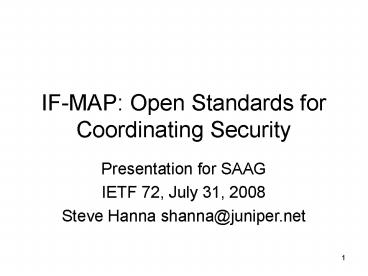IF-MAP: Open Standards for Coordinating Security - PowerPoint PPT Presentation
Title:
IF-MAP: Open Standards for Coordinating Security
Description:
Host Anti-Virus. Host. Security. Network. Firewall. Network ... Network Anti-Virus. Network. Security. Information Security Present. Partial Coordination ... – PowerPoint PPT presentation
Number of Views:101
Avg rating:3.0/5.0
Title: IF-MAP: Open Standards for Coordinating Security
1
IF-MAP Open Standards for Coordinating Security
- Presentation for SAAG
- IETF 72, July 31, 2008
- Steve Hanna shanna_at_juniper.net
2
Information Security Past - Isolation
3
Information Security Present Partial
Coordination
Network AccessControl (NAC)
4
Information Security Future Full Coordination
NAC withIF-MAP
5
Basic NAC Architecture
Access Requestor (AR)
Policy Decision Point (PDP)
Policy Enforcement Point (PEP)
6
Integrating Other Security Systems
Access Requestor (AR)
Policy Decision Point (PDP)
Policy Enforcement Point (PEP)
Metadata Access Point (MAP)
Sensors, Flow Controllers
7
TNC Architecture
PolicyEnforcementPoint
MetadataAccessPoint
Sensors and Flow Controllers
Access Requestor
8
What is IF-MAP?
- Standard Published by Trusted Computing Group
- https//www.trustedcomputinggroup.org/groups/netwo
rk - Standard Requests Responses
- Publish, Search, Subscribe, Poll
- Standard Identifiers
- device, identity, ip-address, mac-address,
access-request - Standard Metadata
- device-attribute, event, role, capability,
layer2-information - Standard Links (marked with metadata)
- access-request-device, access-request-ip,
access-request-mac, authenticated-as,
authenticated-by, ip-mac - Protocol Binding for SOAP
- Ability to define optional vendor-specific
extensions
9
Example IF-MAP Graph
10
IF-MAP Benefits
- More Informed Sensors
- Sensors can tune by role and other things
- Should reduce false alarms
- Policy and Reports in Business Terms
- User identity and role vs. IP address
- Simpler, easier to manage
- Automated Response (if desired)
- Faster response stronger security
- Less expense due to automation
- Customer Choice and Flexibility
- No need to buy all security products from one
vendor - Can reuse and integrate existing security systems
11
Security and PrivacyConsiderations
- MAP Storehouse of Sensitive Data, Critical
Nerve Center - MUST
- TLS with mutual auth for IF-MAP clients
- publisher-id and timestamp to track changes
- SHOULD
- authorization, DOS protection, anomaly detection,
physical and operational security, hardening,
etc. - not keep historical data
12
Discussion































